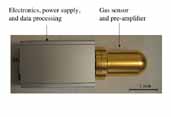When astronauts travel beyond low-Earth orbit — to Mars, moons and asteroids — they will need the capability to actively monitor radiation and be alerted to high radiation levels during solar particle events. Dr. Tore Straume and his team are developing a small, personal radiation monitor for extravehicular activity (EVA) that quickly responds to changing radiation dose rates and types. The final prototype will be about the size of a cell phone and could easily fit inside the backpack of an EVA spacesuit or in a toolbox. It will measure radiation quality for all space radiation types, including secondary neutrons. The project is a collaboration between NASA Ames Research Center, Texas A&M University and Colorado State University.
Overview
Dosimetry: Small Active Dosimetry System for Lunar Extravehicular Activity Missions: Spacesuit and Tool-Box Applications

In this early prototype of the dosimeter, the left side contains the electronics, power supply and data processing, and the right side is the gas sensor and pre-amplifier. The gas sensor was developed by Colorado State University, the pre-amplifier by Texas A&M University, and the electronics and data processing package by NASA Ames Research Center. The complete monitor is the size of a compact cell phone. Click here for larger image.
Principal Investigator:
Tore Straume, Ph.D.
Organization:
NASA Ames Research Center
Technical Summary
The aim of the project is the development of a compact active dosimetry system that can provide real-time radiation monitoring beyond low-Earth orbit (LEO). The dosimetry system would be capable of active, real-time monitoring during both ambient and solar particle event (SPE) conditions. It will be designed to be responsive to the doses, dose rates and radiation qualities (including secondary neutrons) expected in interplanetary space.
As astronauts travel beyond LEO and explore asteroids, the moon and Mars, there will be a critical need for active personal radiation monitoring. Of particular concern is the need for real-time radiation dosimetry information during SPEs, so that astronauts can seek prompt shelter. SPEs occur unexpectedly and with highly variable dose rate and can result in a broad range of doses to astronauts. Also, the quality of the radiation, both primary and secondary, can vary significantly between and within SPEs. It is expected that secondary radiations produced in the spacecraft or in the surface regolith by incident SPE particles, mostly protons, may result in significant neutron contributions to the dose equivalent. This dynamic and complex radiation environment requires the development of suitable detection systems.
This project is a joint effort between NASA Ames Research Center (ARC), Colorado State University (CSU) and Texas A&M University (TAMU). CSU designs and fabricates the tissue equivalent proportional counter (TEPC) sensors, TAMU designs and builds the preamplifier with charge integrator, and ARC designs and builds the miniaturized electronics package with bias voltage power supply and microprocessor. In addition, ARC programs the microprocessor to calculate variance-covariance, dose and dose-equivalent.
Year Three Progress
The Mod 1 versions of these components were integrated with the tissue-equivalent sensors fabricated by CSU and tested using ground-based simulated space radiation. The Mod 1 monitor was exposed to 226 MeV protons, 200 MeV/n C, and 382 MeV/n Fe. The focus of this initial Mod 1 test was to:
- Determine if the detector response behaved as expected for low and high linear energy transfer (LET) radiations,
- Determine if the level of electronic noise in the combined system was low enough to permit the detection of high-energy protons, and
- Look at the angular dependence of the single wire detector.
Measurements were made at four beam angles, and frequency mean lineal energy and dose mean lineal energy were calculated. The results demonstrated that minimally ionizing protons (0.22 keV/µm) are detectable. The results do not show detectable angular dependence within the uncertainties of the measurements. A higher than expected response was observed in the mid LET range for Fe, which is being addressed in Mod 2, and includes improved sensor design, improved low-noise, preamplifier design with built-in integrator circuit and improved miniaturized electronics package with data processing.
Mod 2 will be tested during coming months. Mod 2 also includes variance-covariance capability to obtain radiation quality using a single TEPC detector. Various single and multi-wire sensors, pre-amp models and electronics components are being tested and compared for their performance. The optimum sensor, pre-amp and electronics package will be selected for the final prototype. Initial tests using a neutron source were made of the variance-covariance method, and results show that the monitor operated as planned.
Plans for Coming Year
Complete development and fine tuning of the preamplifier and microelectronics package will occur. This includes completing and testing variance-covariance, completing and testing final miniaturized electronics package with a low-noise, well-regulated direct current power supply, completing modifications and testing of pre-amp charge integrator, and selecting the final components for prototype monitor. This would be followed by performance testing the final prototype assembly which would include the jointly ARC, CSU and TAMU selected Mod 2 sensor designs. The source tests will include the NASA Space Radiation Laboratory and Chiba facilities, as well as proton tests at the 88 inch cyclotron at the University of California, Berkeley.





